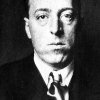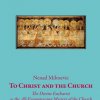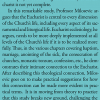THE SERBIAN PATRIARCHATE
Serbian lands greatly increased in their proportions during the reigns of Kings Dragutin, Milutin, Stefan Decanski, and, especially so, during the reign of King Dusan (Dushan). Parallel to the territorial growth of the state, so grew the total number of dioceses of the Serbian Archbishopric. During the lifetime of Saint Sava there were eleven. Those newly formed dioceses of: Lipljan, Koncul (Konchul), Lim, Macva (Machva), Branicevo (Branychevo), Beograd, and Skoplje (Skoplye). Serbian state was territorially the largest during the reign of Emperor Dusan (1331-1355). It was the largest and the most powerful among the contemporary states in the whole of the Balkans. Serbs occupied Thessaly, the region from the Holy Mountain to Christopolis, Epirus and Albania. King Dusan proclaimed himself Emperor in 1346. Byzantium was greatly weakened by internal crisis and Dusan strove to substitute once powerful Byzantine by his own Serbo-Byzantine Empire. He considered himself the Emperor of Serbs and Greeks. In order to legitimise his title he needed to elevate the Serbian Archbishopric to the level of a Patriarchate. This was done on the occasion of a Church-State council held in Skoplje in 1346, on the day of the Feast of the Entrance of Our Lord into Jerusalem. Council was attended by the Bulgarian Patriarch Simeon, Archbishop of Ohrid Nicholas, abbots and elders of the Holy Mountain, as well as those Greek bishops and metropolitans whose dioceses were included in the newly enlarged Serbian state. Council elevated the Archbishopric to a Patriarchate and the first Serbian patriarch was Joanikije I (Joannicius) carrying the title “Patriarch of Serbian and Maritime Lands”. On the Eastern day of 1346, seven days after the above mentioned Church council was held, Dusan was crowned first Serbian Emperor by the Patriarch. His son, Uros “Nejaki” (“The Frail”) was crowned King. Archbishopric of Ohrid was second in honour after the Serbian Patriarchate. Dioceses of Raska, Zeta, Prizren and Skoplje were elevated to Metropolitanates, first in honour among them being Metropolitanate of Skoplje, since Skoplje was the Capital of the Empire.
Emperor Dusan, accompanied by his wife Empress Jelena (Yellena, Helen), visited the Holy Mountain and richly endowed all monasteries there. This event was recorded in Greek and Serbian languages and could be found contained by many a charter existing even today on the Holy Mountain. Hilandar was most richly endowed, as were the Karyes Hermitage of St. Sabas and the Holy Archangels in Jerusalem. Emperor’s chief memorial was the monastery of the Holy Archangels near Prizren (1347) which also served as his mausoleum (1355).
Emperor Dusan is also remembered by his famous zakonik (Dushan’s Legislature) which was adopted by the State Assembly in Skoplje (1349), and developed by the Assembly in Ser (1354). This Legislature is considered to be one of the best and most perfect legislative acts of the period in Europe. For example, Article 172 of this Legislature — and not according to their fear of Our opinon and will”. First 38 articles of this Legislature are exclusively concerned with the Church. Patriarch’s title was similar to that of the Emperor: “By the Grace of God Archbishop of All Serbian and Maritime Lands”. According to medieval law, Patriarch’s Court was considered a place of sanctuary (refuge) for all those seeking protection from the State.
A few years after the Serbian Patriarchate was established there came a reaction to it in a form of an official objection from Byzantium, since the Byzantine Empire felt that its interests were damaged by Emperor Dusan’s political actions. Emperor John Cantakuzenos, once Dusan’s friend and collaborator, now became his opponent. He persuaded Callistus, Patriarch of Constantinople, to anathematize Serbian Emperor, Serbian Patriarch, Church and the people, and this was done in 1353. It was said that the basic reason for such an action was to safeguard “dignity and cities”, i.e. to protest against Serbian Archbishopric becoming a Patriarchate, and against such actions by which Greek bishops were substituted by Serbs in those cities that Dusan took from Byzantium.
Empero Dusan himself tried to reconcile with the Patriarchate of Constantinople. Negotiations in such a direction were continued after his sudden death (December 20th, 1355). The new Byzantine Emperor John V sent Patriarch Callistus to the court of Empress dowager Helen (who after her husband’s death became a nun and changed her name to Elisabeth) at the city of Ser to negotiate a reconciliation in face of an imminent danger both Byzantium and Serbia were faced with — that danger was the Ottoman Turks. It happened that Patriarch Callistus took ill and died in Ser, and that his funeral was officiated by those priests whom he himself had once anathematized.
The process of reconciliation lasted for years, and a partial agreement was reached first (a particular unity) with the region of Ser, i.e. that part of Serbian Empire ruled by Despot Ugljesa Mrnjavcevic (1368, Uglyesha Mrnyavchevich). His domain was first to be directly threatened by the Turks. Final reconciliation was envisaged and achieved by monks of the Holy Mountain, those of Greek and Serbian provenience, since they both lived and prayed together. A monk delegation headed by a Serbian elder Isaija (Isaiah) and hieromonk Nikodim Grcic (Nikodemus Grchich) first visited Knez Lazar’s court in Serbia where it also met with Patriarch Sava IV. In 1375 the same delegation proceeded to Constantinople. An agreement was reached whereby canonical validity of the Serbian Patriarchate was recognised by Constantinople. Two of its representatives were dispatched to Prizren where they celebrated the Holy Liturgy in the monastery of the Holy Archangels, and, thus, officially lifted the previously imposed anathema.
After Emperor Dusan’s death in 1355 Serbia could not offer a strong ruling personality that could manage to keep together the vast Serbian Empire. Regional Lords became completely independent and tended to ignore central authority embodied by Emperor Uros “the Frail”, the last ruler of Nemanjic dynasty. Internal disunity and unavoidable external danger of Ottoman invasion became Serbian reality. During his lifetime even Emperor Dusan took some limited military action against Turks. One of the most important Serbian military defeats happened on September 26th 1371 at the battle of Marica (Marytsa) where both King Vukasin (Vukashyn) and his brother Despot Ugljesa lost their lives. Emperor Uros died by the end of the same year. It became clear that it was only a matter of time before decentralized Serbian lands would fall prey to the Mohammedan invader.
Some Serbian lands eventually came to be centralised again, this time under the rule of Knez Lazar Hrebeljanovic (Hrebelyanovich) who, himself, did not belong to the Nemanjic dynasty, but his wife Milica (Mylitsa) did. He proved to be the most energetic among nobles in defending Serbian statehood and Nemanjic spiritual heritage. North-east region of Morava and Danube river valleys now became heartlands of the new state where many of the important monasteries were to be built: Ravanica (1381, Ravanytsa), Lazarica (Lazarytsa), Gornjak (Gornyak), Ljubostinja (Lyubostinya) etc. Battle of the Field of Kosovo (28th/15th June 1389) proved to be crucial to the future of the Serbian nation. Knez Lazar lost both this battle and his life to the Ottoman Turks, together with most of his nobility, lesser nobility and soldiers. It was an honourable defeat since their resistance to the invader proved to be a consciously Christian act of martyrdom against militarily far superior forces of the foe. This sacrifice is even more noteworthy if one considers the lack of readiness on part of some other Serbian noblemen to follow Knez Lazar’s example.
Not all Serbian lands came under Ottoman rule immediately after the battle of the Field of Kosovo, but Serbia became a tributary state to the Turks. Two Serbian patriarchs, Spiridon (Spyridon) and Jefrem (Ephraem), are mentioned as contemporaries to these events. Jefrem was a great ascetic and an anchorite monk — a hesycast. It is important to say that hesychasm, as a spiritual movement, took deep roots in Serbia precisely during Knez Lazar’s rule since he, himself, took a great deal of interest in it. Many of the monks fleeing from the Ottoman peril in the East took refuge in Knez Lazar’s Serbia. There is evidence of considerable hesychastic spiritual influence on Serbian literature, icon painting, and sacred architecture of the time. Only strong and unrelenting faith could give spiritual and moral meaning to the life of the nation after the defeat of Kosovo.
Knez Lazar’s successor to the throne was his son Stefan Lazarevic (+1427, Stephan Lazarevich) under whose rule Serbia came to recover as a state managing also to restore its economy. Stefan received title of despot after the successful outcome of his participation at the battle of Angora in 1402. Spiritual and economic recovery of Despot Stefan’s Serbia is best witnessed by his memorials — monasteries of Manasija (Manasya) or Resava, Kalenic (Kalenych) etc., which were all built in the distinct Serbo-Byzantine architectural style.
Manasija became a great spiritual and educational centre of the Despotate. “Resava school”, as a style in literature, art and architecture, became a symbol of learning for centuries to come. This school engaged a great number of learned monks — writers, biographers, scribes, copyists and translators. It was a centre of literacy and spread its influence all the way to Russia and Rumania. Metropolitan Cyprian of the Russian Orthodox Church came from Serbia, as did Gregory Tzamblak — Metropolitan of Kiev, previously abbot of Decani (author of the Biography of St. Stefan Decanski). Serbian monk Pahomije (Pachomius) was also a well-known contemporary who became famous in Russia as a writer. Despot Stefan’s court was moved to Beograd, which became the principal town of Serbia. He was a very learned nobleman; he read a lot and was, himself, a successful author. His became famous for his passage “Slovo Ljubve”.
Despot Djuradj Brankovic (1427-1456, George Brankovich) was one of the last Serbian rulers before the final fall under Turkish yoke in 1459. His was the last attempt to defend Serbia against the aggressor. Despot Djuradj was known for his strong and decisive faith in God as well as for his faithfulness to the rich spiritual and national heritage. He refused to accept Union with the Roman Catholics (Councils of Ferrara and Florence 1438-1439) who gave false promises of military assistance against Turks. His significant answer to the Franciscan John Capistranus was as follows: “Ninety years of my life I have lived with this faith that had been poured into my soul by my ancestors and have, as a result, been considered a wise, although unfortunate, man by my people. Now you would like them to think, if I should change, that I have become senile of old age and, as the commoners say, infantile. I would rather agree to die than betray the faith of my ancestors”. Patriarchal See was moved from monasteries Pec and Zica to the last free bastion — to the fortress of Smederevo.
During the medieval period Serbian Church had a significant, if not even principal, role in the lives of every individual and the state as a whole. Relationship between the Church and the State was natural and harmonious, and was most often compared to the human organism and the relationship between the soul and the body. According to his nature man is a harmonious being, if healthy, of course. Church and State interests were not in conflict but, rather, mutually compatible. This is a case where the well-known theory of symphony between Church and State was applied almost to its fullness. Church was materially and financially completely independent. Every diocese owned land, priests were entitled to “popovski bir” and some land they could cultivate for their own needs. Priestly vocation was most commonly a hereditary right.
Monasteries and monks had especially significant and unique roles in the Serbian medieval society. Monasteries of Studenica, Zica, Pec, Mileseva, Sopocani, Decani, Ravanica, Manasija, etc., all founded by royal donators, outlived the State and centuries of captivity. They shine out in a very particular light and radiate a message witnessing eternal spiritual values which have, for centuries, served to deliver Serbian people from all calamities of life and to inspire them during both good and the bad times. Monasteries, monks and nuns, regardless of living either coenobitic or solitary lives, best witnessed the practice of life in Christ (as far as this is at all attainable considering all weaknesses, and shortcomings of every human being). It is very characteristic of Serbian monasteries that the have always been open to communal life. They served as open houses for all those who were in need. There were times when monasteries substituted schools, hospitals, all kinds of artistic and artisan workshops. They were often used as a place of refuge from enemy raiding parties, and, last but no least, they were places of eternal rest — they all had cemeteries.
Serbs were taught literacy in order to understand Christianity better. This is why monk Sava is considered both a saint and a writer. He was emulated by his brother and king Stefan Prvovencani when he wrote the Biography of St. Simeon, and also by Domentijan (Domentian) the monk and his Biography of St. Sava, and Biography of St. Simeon. Their opus was followed by Theodosius the monk with his Biography of St. Sava and Biography of St. Petar Koriski (Peter of Korish), and by many other known and unknown monk-authors. They themselves did not attain literacy just for the sake of becoming literate, nor did they teach it to others for the same reason. They did this to that they could enrich their own experience of Christianity and bring salvation in faith to others. For many of them writing was just another form of prayer. We shall mention just a few more of these remarkable people: Archbishop Nicodemus, translator of Typikon; Archbishop Daniel II (Biographies of Serbian Kings and Archbishops); Patriarch Ephrem; Patriarch Daniel III; Bishop Mark (Biography of and Service to Patriarch Ephraem, …); Despot Stefan Lazarevic (Word of Love); Eufemia the nun (Homage to Knez Lazar); Gregory Tsamblak (Biography of and Service to St. Stefan Decanski, On the Transfer of Relics of St. Paraskeve); Consantine the Philosopher (Biography of Despot Stefan, …).






